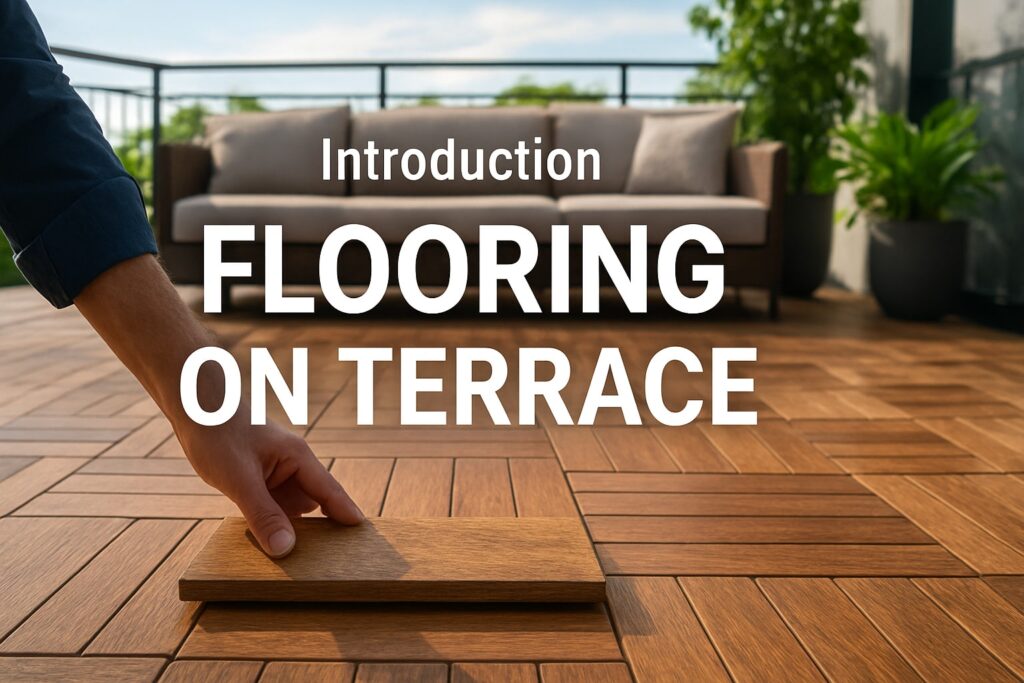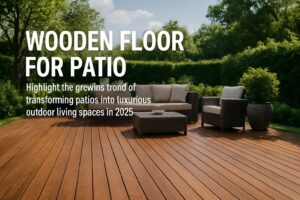Transforming your terrace into a functional outdoor living space is more popular than ever, with homeowners seeking both comfort and style. The right flooring on terrace is essential for creating a durable and inviting area that stands up to the elements while reflecting your personal taste.
This expert guide explores the latest 2025 trends, innovative materials, and proven installation methods for flooring on terrace. You will discover fresh design inspiration and professional tips to help you achieve a beautiful, long-lasting outdoor retreat. Ready to elevate your terrace? Let’s dive into everything you need to know to make your space exceptional.
Top Terrace Flooring Trends for 2025
The demand for innovative flooring on terrace spaces is soaring, with homeowners seeking options that blend style, sustainability, and practicality. As we look ahead to 2025, several key trends are reshaping how terraces are designed and enjoyed. From eco-friendly materials to smart flooring systems, these trends offer inspiration and guidance for anyone planning a terrace makeover. For a more comprehensive look at what's driving the market, see the latest Outdoor Flooring Trends 2025.
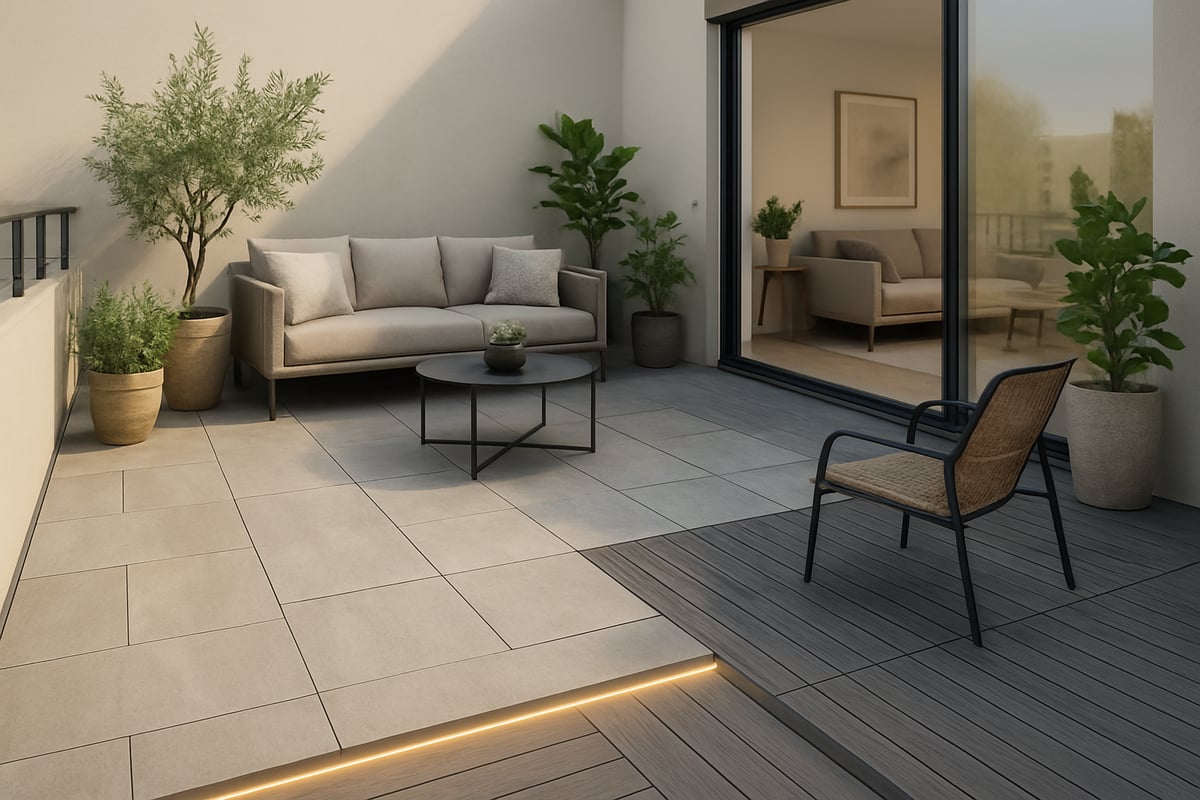
Sustainability and Eco-Friendly Materials
Sustainability is at the forefront of flooring on terrace design for 2025. Homeowners are increasingly seeking materials that minimize environmental impact without sacrificing performance. Recycled composite tiles, FSC-certified hardwoods, and ethically sourced natural stone are leading choices.
Eco-friendly terrace flooring options not only reduce carbon footprints but also attract buyers looking for green credentials. Transparency in sourcing and third-party certifications are becoming standard expectations. According to industry reports, the market for sustainable outdoor flooring is projected to grow significantly in the coming year, reflecting the rising consumer demand for responsible choices.
Choosing sustainable flooring on terrace projects also enhances resale value, as buyers are drawn to properties with energy-efficient and low-maintenance features.
Seamless Indoor-Outdoor Transitions
Creating a seamless visual flow between indoor and outdoor spaces is a top trend in flooring on terrace design. Matching materials, such as porcelain pavers, composite tiles, or engineered wood, help extend the living area and make the terrace feel like a natural extension of the home.
This approach is especially popular in urban settings where maximizing perceived space is crucial. By using consistent colors and textures, terraces appear larger and more modern. Leading brands now offer collections designed specifically for indoor-outdoor continuity, making it easier to achieve these results.
Real-life installations often showcase living rooms with sliding doors that open onto terraces featuring the same flooring on terrace, blurring boundaries and enhancing overall appeal.
Large-Format and Modular Systems
The use of large-format pavers and modular tile systems is transforming flooring on terrace projects. Oversized tiles reduce grout lines, resulting in a cleaner, more contemporary look. Modular systems allow for quick installation and easy customization.
Popular in 2025 are pavers measuring 24×24 inches or larger, with modular patterns like herringbone or checkerboard gaining traction. These systems simplify maintenance and accommodate future upgrades or repairs.
Case studies show that modular flooring on terrace spaces is ideal for both residential and commercial applications, offering flexibility and speed without compromising on aesthetics.
Textured, Non-Slip, and Weather-Resistant Surfaces
Safety and comfort are essential when selecting flooring on terrace surfaces, especially in regions with variable weather. The latest materials feature advanced slip-resistant textures and tactile finishes that remain comfortable underfoot, even in wet conditions.
Many products now boast R12 slip-resistance ratings and frost-resistant properties, ensuring long-term durability. Homeowners appreciate surfaces that are easy to clean and maintain, reducing the risk of slips and falls.
Manufacturers are also introducing finishes that mimic natural textures while providing superior traction. These innovations in flooring on terrace design make outdoor spaces safer and more inviting year-round.
Smart & Multifunctional Flooring Solutions
Technology is making its mark on flooring on terrace design. Smart features such as integrated LED lighting, built-in drainage, and even heating elements are increasingly available. Modular flooring with removable panels provides easy access to subfloors for maintenance or upgrades.
Recent projects highlight terraces equipped with programmable lighting embedded in the flooring, enhancing ambiance and safety. Built-in drainage systems help prevent water pooling, protecting both the surface and the underlying structure.
These multifunctional solutions reflect the growing demand for terraces that are not only attractive but also adaptable and resilient, ensuring that flooring on terrace installations meet the needs of modern living.
Choosing the Best Terrace Flooring Material
Selecting the right flooring on terrace projects is essential for both style and functionality. The right material ensures your outdoor space is comfortable, safe, and durable through all seasons. Let us explore the top options for 2025, highlighting the advantages and unique features of each.
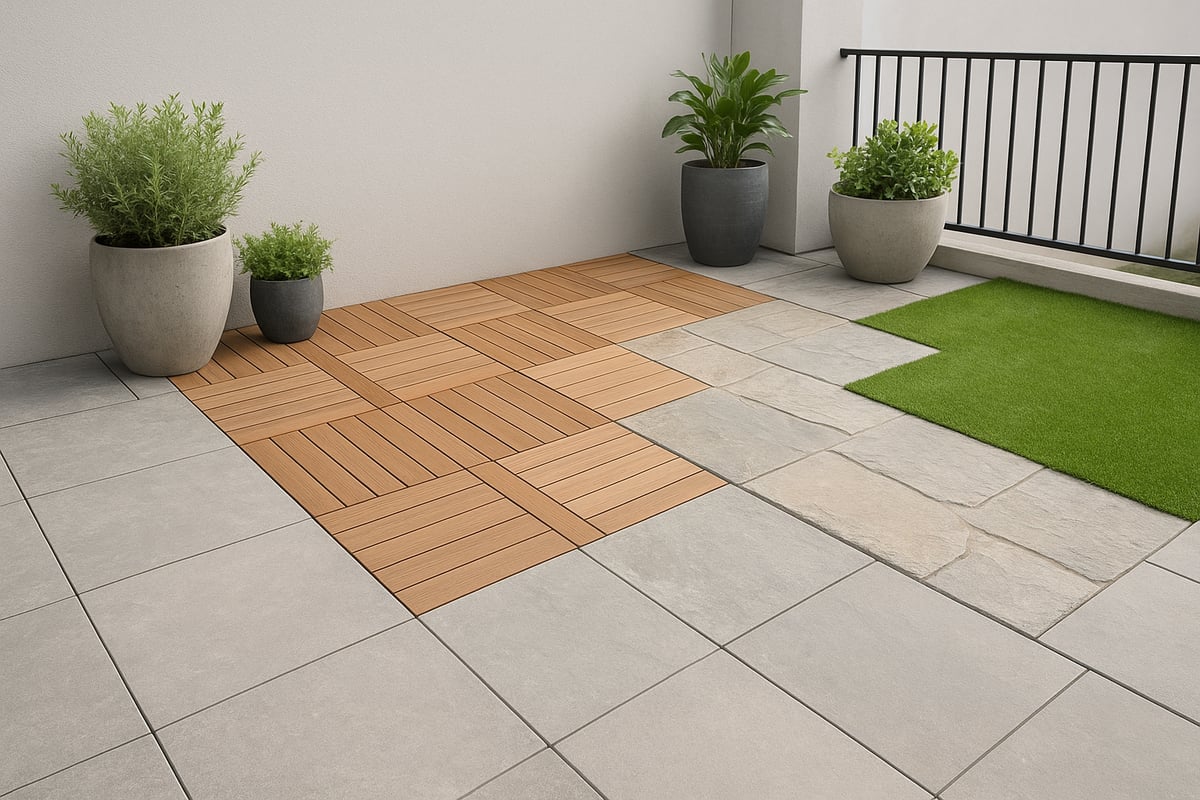
Porcelain Pavers and Tiles
Porcelain pavers have become a leading choice for flooring on terrace spaces, thanks to their impressive durability and style flexibility. These pavers resist frost, stains, and slips, making them ideal for Canadian and northern climates. Modern manufacturing allows porcelain to mimic stone, wood, or concrete finishes, fitting any design vision.
Installation is versatile. Options include pedestal systems for easy drainage or adhesive for more permanent solutions. Many premium porcelain pavers, such as Italian 2CM varieties, come with warranties up to 20 years. These pavers require minimal maintenance and retain their color and texture for years, making them a practical investment for high-traffic terraces.
Composite Deck Tiles
Composite deck tiles are another top contender for flooring on terrace upgrades in 2025. These tiles combine recycled wood fibers with advanced plastics, offering an eco-friendly and weather-resistant solution. Homeowners love the easy click-together installation, which is perfect for condos or rental properties.
A wide selection of colors and wood grain patterns allows you to match any outdoor décor. Composite tiles are designed to withstand UV rays, rain, and snow without fading or warping. For those interested in more details about installation and product options, Modular composite deck tiles provide a comprehensive guide. Warranties often exceed 10 years, and recent wind-testing data shows excellent performance in rooftop settings.
Natural Stone and Exotic Hardwoods
For those seeking timeless elegance, natural stone and exotic hardwoods offer a luxurious approach to flooring on terrace projects. Materials like IPE, granite, and limestone bring unique grain and color variations, elevating the aesthetics of any terrace. These materials are often featured in high-end residential and commercial spaces.
However, they do require regular sealing and maintenance to preserve their finish and slip resistance. In colder climates, it is important to choose stones with low water absorption to prevent cracking. Exotic hardwoods like IPE are naturally dense and resistant to moisture, making them suitable for outdoor use with proper care.
Outdoor Concrete and Engineered Surfaces
Concrete tiles and engineered slabs are a modern solution for flooring on terrace spaces, especially those with a minimalist or industrial design. These surfaces can be customized with various textures, matte finishes, and color options, allowing for a truly bespoke terrace.
One advantage is the ability to repair or refresh the surface easily if damaged. Concrete-look pavers are trending in contemporary rooftop designs, offering a seamless appearance with fewer grout lines. Engineered surfaces are particularly popular for their durability and ease of maintenance, even in areas with extreme weather.
Artificial Turf and Hybrid Solutions
Artificial turf is gaining popularity for flooring on terrace areas where comfort and play are priorities. Today’s turf closely mimics natural grass in both appearance and feel, making it great for families or pet-friendly terraces. Hybrid solutions that combine turf with modular tiles can create multipurpose zones for relaxation and recreation.
Proper drainage and regular brushing help maintain turf quality throughout the year. Advances in turf technology have improved UV resistance and reduced heat retention, making these installations comfortable even on sunny days. Hybrid setups are especially useful for small or urban terraces where every square foot must serve multiple functions.
Step-by-Step Guide to Terrace Flooring Installation
Transforming your outdoor area starts with a well-planned installation process. This step-by-step guide ensures your flooring on terrace is built to last, safe, and visually appealing. Each stage is crucial for achieving a professional result and maximizing the potential of your space.
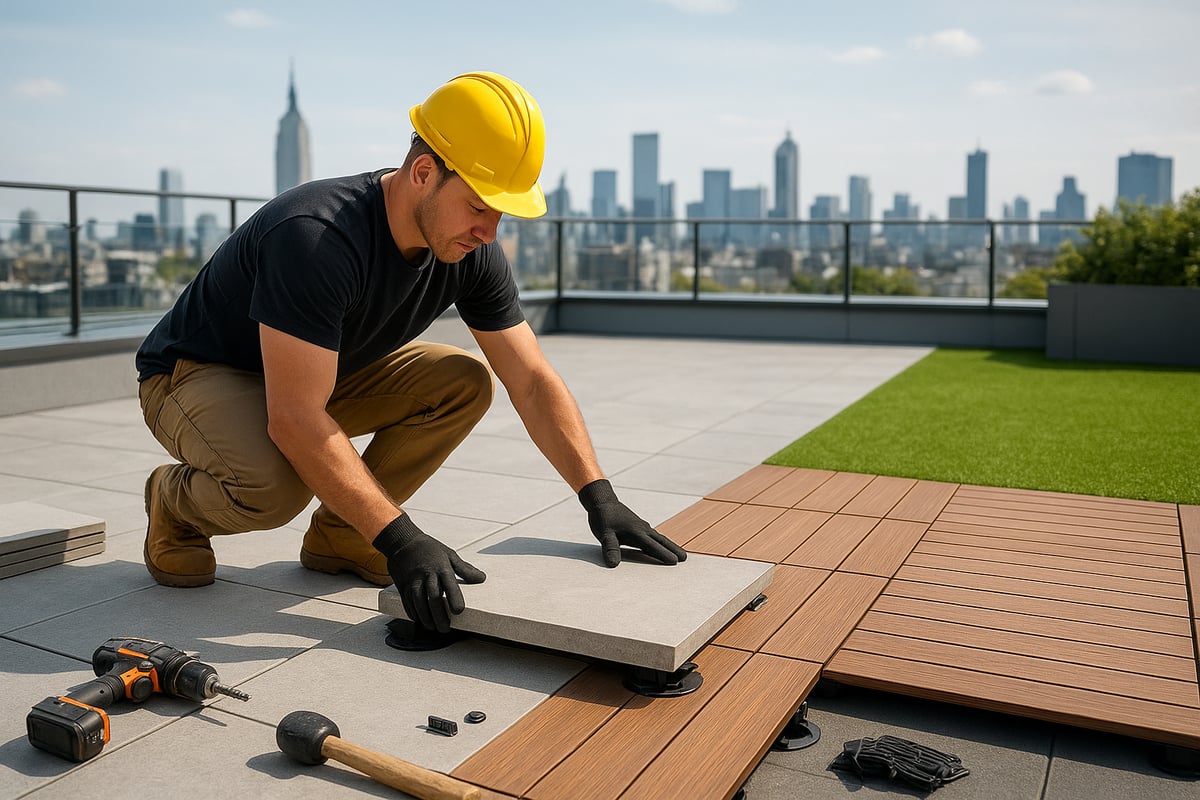
Step 1: Assessing Your Terrace and Structural Needs
Before you begin, assess your terrace’s structural integrity. Check the load-bearing capacity to ensure it can support new flooring on terrace, especially for heavy materials like porcelain or stone.
Review building codes and condo regulations. Many multi-unit buildings require removable or floating systems to protect waterproofing and allow for inspections. Inspect the existing membrane for any signs of damage or leaks.
Evaluate drainage and slope. A proper slope prevents water pooling and reduces maintenance. Address any issues now to avoid problems later. Taking time for these checks sets the foundation for a safe and durable terrace.
Step 2: Selecting the Right Flooring Material and System
Choosing the right system is essential for performance and design. Match flooring on terrace to your climate, usage, and style preferences. Consider slip-resistance, UV stability, and ease of maintenance.
Porcelain pavers, composite tiles, natural stone, and artificial turf each offer unique benefits. Use visualization tools or design consultations to compare options. For more inspiration, explore these Terrace flooring ideas and tips to discover materials that align with your needs.
Ensure your choice is compatible with building codes and subfloor conditions. Quality materials and planning prevent future headaches.
Step 3: Preparing the Surface
Preparation impacts the longevity of flooring on terrace. Start by thoroughly cleaning the surface, removing debris and checking for moisture issues. Level uneven areas to avoid trip hazards and ensure proper drainage.
If your terrace has a membrane, protect it during installation. Use non-penetrating supports like adjustable pedestals or floating systems to prevent damage. Address any waterproofing repairs before proceeding.
Take time to confirm the area is ready. Proper preparation makes installation smoother and helps protect your investment for years to come.
Step 4: Installation Techniques
Installation methods vary depending on the chosen flooring on terrace. Dry-lay systems are popular for modular tiles and pavers, offering easy removal and replacement. Adhesive methods provide a more permanent finish but may not suit every subfloor.
For raised pedestal systems, start at one corner and check level frequently. Modular tiles often click together for fast results and immediate use. Always follow manufacturer instructions for expansion gaps and drainage.
Walk on the surface only after confirming stability. Professional installation ensures safety, but DIY projects are possible with careful planning.
Step 5: Finishing Touches and Safety
The final details elevate your flooring on terrace. Install edge trims to secure tiles and create a polished look. Add planters, outdoor rugs, or LED lighting to enhance ambiance and comfort.
Check that drainage paths remain clear. Ventilation under raised floors prevents moisture buildup and extends the life of your materials. Complete a final inspection, noting any loose tiles or uneven spots.
Plan regular maintenance to keep your terrace looking its best. These finishing steps make the space both beautiful and functional.
Common Installation Mistakes to Avoid
Avoiding common pitfalls protects your investment in flooring on terrace. Do not overlook the importance of slope and drainage, as trapped water leads to damage and mold. Always test for slip-resistance, especially in wet or icy climates.
Use only code-compliant, weather-resistant materials approved for your building type. Skipping subfloor inspections or neglecting waterproofing can cause costly repairs. Document the installation process for warranty and future reference.
Careful planning and attention to detail help you achieve a safe, stylish, and long-lasting terrace floor.
Design Inspiration: Creating a Stylish, Functional Terrace
Designing a terrace that feels both inviting and practical starts with the right approach to flooring on terrace. The latest trends for 2025 prioritize harmony between indoor and outdoor spaces, clever zoning, and high-performance materials. Here are expert design strategies to inspire your own transformation.
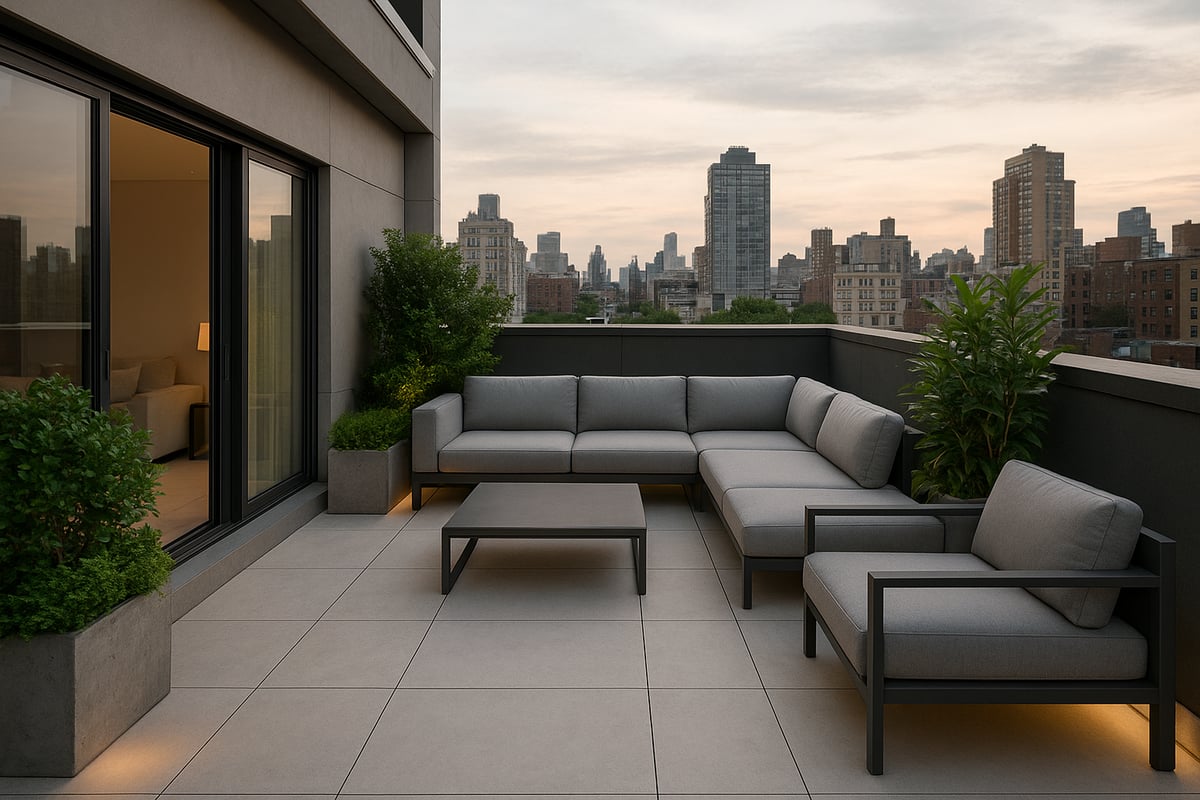
Blending Indoor and Outdoor Aesthetics
Achieving a seamless transition between your home and terrace is a top priority in modern design. The flooring on terrace should echo the tones and textures of your indoor floors, making the entire living area feel larger and more cohesive.
Consider using materials like porcelain pavers for terraces that provide both durability and a range of finishes, from natural stone to wood-look. Matching indoor and outdoor patterns, or opting for similar color palettes, can visually connect spaces.
- Use large-format tiles for a continuous flow.
- Select neutral shades to unify indoor and outdoor zones.
- Extend living room aesthetics with outdoor rugs and modular furniture.
By focusing on these details, you ensure the flooring on terrace enhances both comfort and visual appeal.
Zoning and Layout Ideas
Creating zones on your terrace maximizes functionality and encourages multiple uses. The right flooring on terrace can help define areas for dining, lounging, or gardening without physical barriers.
- Lay tiles in different patterns for each zone.
- Use modular deck tiles to frame specific spaces.
- Incorporate planters or low dividers as natural boundaries.
Strategic placement of furniture and color-blocked flooring sections can make even compact terraces feel organized and spacious. This approach not only improves usability but also adds a layer of visual interest.
Accessorizing for Comfort and Ambiance
Accessories are essential for transforming flooring on terrace into a welcoming retreat. Layering textures, adding greenery, and integrating lighting all contribute to a cozy atmosphere.
- Choose weatherproof outdoor rugs for softness underfoot.
- Add planters with seasonal flowers for color and vibrancy.
- Install LED lights along pathways or seating areas for evening use.
For inspiration, consider the latest Flooring Trends 2025 that emphasize high-tech features and tactile finishes. These elements personalize your terrace and make it suitable for year-round enjoyment.
Maximizing Small or Urban Terraces
Urban terraces often require creative solutions to make the most of limited space. Hybrid options, like combining tiles with artificial turf terrace options, can transform flooring on terrace into a multifunctional area for play, relaxation, or entertaining.
- Use modular flooring for quick reconfiguration.
- Install vertical gardens to maximize greenery.
- Opt for foldable furniture to free up floor space as needed.
These strategies allow you to enjoy every inch of your terrace, regardless of size, while maintaining style and comfort.
Weatherproofing and Year-Round Use
Selecting weather-resistant materials is crucial for flooring on terrace, especially in regions with varied climates. Consider surfaces that offer slip resistance, frost protection, and easy drainage to ensure safety and longevity.
- Install retractable shades or pergolas for sun and rain protection.
- Choose flooring materials rated for outdoor durability.
- Add portable heaters or fire tables for cooler months.
By planning for all seasons, your terrace becomes a functional extension of your home throughout the year. The right design choices ensure lasting beauty and minimal upkeep.
Expert Tips for Terrace Flooring Longevity & Maintenance
Proper care and proactive maintenance are essential for keeping your flooring on terrace beautiful and functional year after year. Below, discover expert strategies to maximize durability, reduce repairs, and ensure your outdoor space remains a standout feature.
Cleaning and Care Best Practices
Routine cleaning is the foundation for preserving flooring on terrace surfaces. Sweep debris weekly to prevent scratches and buildup. For porcelain pavers or composite tiles, use mild soap and water with a soft-bristle brush. Avoid harsh chemicals that can damage finishes or harm surrounding plants.
For natural stone and hardwoods, opt for pH-neutral cleaners and microfiber mops. Promptly remove organic matter like leaves to prevent staining. Establish a seasonal deep cleaning schedule to address embedded dirt and maintain the original appearance of your flooring on terrace.
Seasonal Maintenance Checklist
Each season brings unique challenges for flooring on terrace. In spring, inspect for winter damage and reseal surfaces if needed. Summer requires monitoring for UV fading and cleaning pollen or dust. Fall is ideal for clearing leaves and checking drainage.
Winter preparation is crucial. Remove furniture and cover delicate areas before freezing temperatures. Ensure snow and ice are cleared promptly using plastic shovels to avoid scratching. This checklist will extend the life of your flooring on terrace and prevent costly repairs.
- Sweep and clean regularly
- Inspect edges and joints
- Reseal as recommended
- Check for drainage issues
Preventing Common Problems
Moisture buildup, mold, and staining are common threats to flooring on terrace installations. Always ensure proper drainage by maintaining clear gaps and clean outlets. Use non-slip mats in wet zones to boost safety and reduce wear.
To avoid mold, allow surfaces to dry after rain and avoid placing planters directly on the floor. For stubborn stains, use manufacturer-approved spot treatments. These preventative actions will keep your flooring on terrace looking new and performing well.
Repair and Replacement Insights
Modular flooring systems make repairs straightforward. If a tile or plank is damaged, replace only the affected piece without disturbing the rest. For glued or mortared surfaces, consult a professional for safe removal and replacement.
Natural materials like stone or hardwood may require periodic resealing or refinishing to maintain resilience. Minor chips can often be repaired with color-matched fillers. Regular inspections help you identify issues early and protect your flooring on terrace investment.
Extending Lifespan and Warranty Considerations
Registering products for warranty coverage is a smart step for anyone investing in flooring on terrace. Follow the manufacturer's recommended care guidelines to maintain eligibility. Schedule annual professional inspections to catch potential problems before they escalate.
Stay up to date with Top Flooring Trends 2025 to select materials and finishes designed for longevity and easy maintenance. This approach ensures your terrace remains both stylish and durable for years to come.
Sustainability and Responsible Upgrades
When upgrading flooring on terrace, consider recycling old materials through local programs or repurposing them for garden paths. Choose new materials with green certifications and low environmental impact. Responsible upgrades not only benefit the planet but also help maintain or even increase your property's value.

